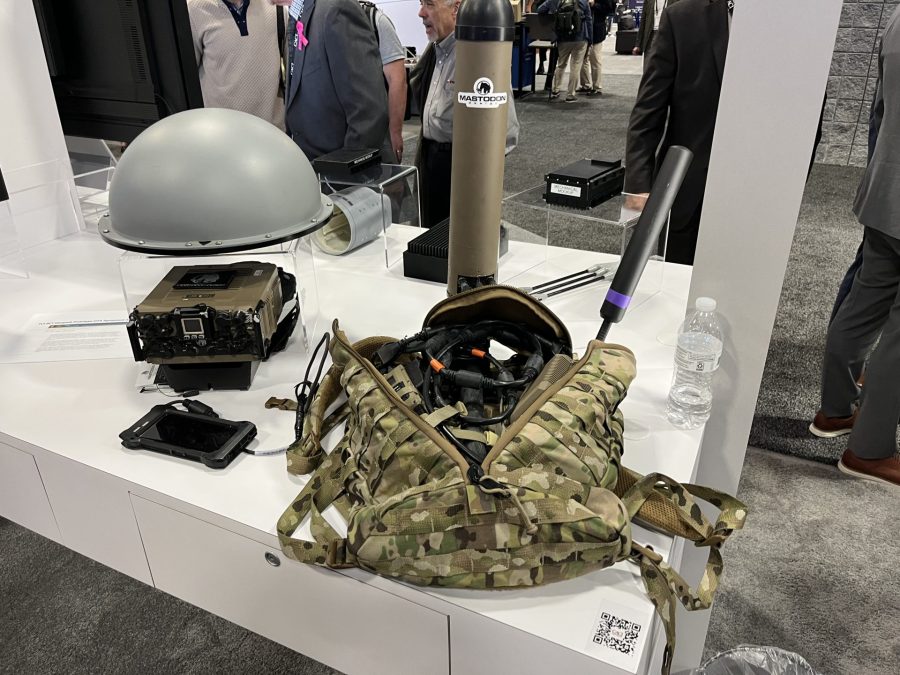Army awards nearly $100M manpack electronic warfare procurement contract

The Army awarded a nearly $100 million procurement and fielding contract to Mastodon Design LLC for a dismounted electronic warfare system, the service announced Monday.
The CACI subsidiary will provide systems for the Terrestrial Layer System-Brigade Combat Team Manpack, the first official program in decades for a dismounted electronic attack capability that soldiers can use to conduct jamming on-the-move as well as direction and signal finding with limited signals intelligence capabilities.
It is associated with the TLS family of systems, which include:
- TLS-BCT: As initially conceived, this was to be the first brigade-organic integrated cyber, signals intelligence and EW system designed for Stryker platforms, however, acquisition priorities shifted and the effort will now likely be split into two distinct signals intelligence and electronic warfare variants. The Lockheed Martin-made capability will be a key enabler of Army priorities — considering the service has been without a program-of-record jammer for decades — and support multi-domain operations.
- TLS-EAB: Designed primarily for divisions, corps and Multi-Domain Task Forces to sense across greater ranges than its brigade-level counterpart, the tool is also being built by Lockheed Martin.
Mastodon was awarded a $1.5 million prototype other transaction authority agreement for the system in September, based upon its Beast+ and Kraken technologies that have been used by special operations forces.
“The efforts to demonstrate, test, and rapidly procure a COTS-based product significantly accelerated the procurement timeline and will result in early capability to the field starting this year. The TLS BCT Manpack is a mature, well-adopted system that will make a significant contribution to winning the Electromagnetic Spectrum (EMS) fight,” Ken Strayer, project manager for electronic warfare and cyber within program executive office for intelligence, electronic warfare and Sensors, said in a statement.
CACI officials have maintained that given their system has been in use by special operations forces, the Army’s approach to use a mature system shortens the timeline for fielding the equipment to conventional soldiers.
“We are making the transition to production after successfully completing prototyping and conducting demonstrations with multiple soldier touchpoints. Through TLS BCT Manpack program, CACI will deliver to the Army a tailorable, modular, low [size, weight and power] solution that integrates and delivers significantly improved SIGINT and EW capabilities to soldiers at the tactical edge,” Todd Probert, president of national security and innovative solutions at the company, told DefenseScoop in a statement.
“Our fully configurable system can conduct radio frequency survey, collection and direction-finding operations, electromagnetic attack and force protection operations, and EMS visualization and scanning/surveying operations. CACI’s Manpack solution leverages hardware that is qualified for use by the Joint Force with a software defined radio architecture specifically designed to meet the Army’s mission requirements. This contract further reinforces our leading position within the tactical EW & SIGINT market,” he added.
The Army program office noted that the Manpack system received approval to transition to Middle Tier Acquisition and rapid fielding with a first unit issued is slated for 2024.
Over the past two budget cycles, the Army has shifted its spending approach for TLS-BCT in funding and quantities to prioritize the Manpack capability. The program office has sought to accelerate the procurement and fielding of the Manpack to include 52 systems in fiscal 2024 and 51 in fiscal 2025, an increase from last year.
The Army has moved to rebuild its electronic warfare arsenal after divesting much of its capabilities following the end of the Cold War.
To date, such dismounted systems were quick-reaction capabilities in response to urgent operational needs. The technology is essential, as the only other EW systems in development are either designed to be airborne or mounted on large platforms such as Stryker vehicles. Dismounted capabilities will be needed to allow soldiers to be more mobile and agile, especially in theaters such as the Pacific with dense terrain and many islands.
The Army has also added a counter-drone requirement to the Manpack program given how pressing that challenge is, as evidenced in Ukraine.
The Manpack system participated in the Army’s Project Convergence Capstone 4 event earlier this year, an Army and joint effort to prototype concepts and capabilities in a real-world combat scenario to test the Pentagon’s Combined Joint All-Domain Command and Control (CJADC2) concept for how systems across the entire battlespace from all the services and key international partners could be more effectively and holistically networked to provide the right data to commanders for better and faster decision-making.
Officials at the exercise noted the Beast+ system in particular successfully relayed electronic signals from soldiers on the ground at White Sands Missile Range, New Mexico, to the command center at Camp Pendleton, California, for them to take action against. This was a big milestone for those teams to be able to find signals of interest and transmit them to higher headquarters to better understand the electromagnetic spectrum environment and, if needed, allow more advance time for reprogrammers to make adjustments to those signals of interest.
Correction: A previous version of this story incorrectly stated the contract value for the deal that was awarded to Mastodon Design LLC for a dismounted electronic warfare system. This story was updated on July 1, 2024, at 12:50 PM, to reflect the correct value.



